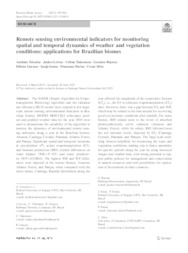Remote sensing environmental indicators for monitoring spatial and temporal dynamics of weather and vegetation conditions: applications for Brazilian biomes.
Remote sensing environmental indicators for monitoring spatial and temporal dynamics of weather and vegetation conditions: applications for Brazilian biomes.
Author(s): TEIXEIRA, A. H. DE C.; LEIVAS, J. F.; TAKEMURA, C. M.; SILVA, G. B. S. da; GARCON, E. A. M.; SOUSA, I.; CESAR SILVA
Summary: Abstract: The SAFER (Simple Algorithm for Evapotranspiration Retrieving) algorithm and the radiation use efficiency (RUE) model were coupled to test large-scale remote sensing environmental indicators in Brazilian biomes. MODIS MOD13Q1 reflectance product and gridded weather data for the year 2016 were used to demonstrate the suitability of the algorithm to monitor the dynamics of environmental remote sensing indicators along a year in the Brazilian biomes, Amazon, Caatinga, Cerrado, Pantanal, Atlantic Forest, and Pampa. Significant spatial and temporal variations in precipitation (P), actual evapotranspiration (ET), and biomass production (BIO) yielded differences on water balance (WB = P−ET) and water productivity (WP = ET/BIO). The highest WB and WP differences were detected in the wettest biomes, Amazon, Atlantic Forest, and Pampa, when compared with the driest biome, Caatinga. Rainfall distribution along the year affected the magnitude of the evaporative fraction (ETf), i.e., the ET to reference evapotranspiration (ET0) ratio. However, there was a gap between ETf and WB, which may be related to the time needed for recovering good soil moisture conditions after rainfalls. For some biomes, BIO related most to the levels of absorbed photosynthetically active radiation (Amazon and Atlantic Forest), while for others, BIO followed most the soil moisture levels, depicted by ETf (Caatinga, Cerrado, Pantanal, and Pampa). The large-scale modeling showed suitability for monitoring the water and vegetation conditions, making way to detect anomalies for specific periods along the year by using historical images and weather data, with strong potential to support public policies for management and conservation of natural resources and with possibilities for replication of the methods in other countries.
Publication year: 2023
Types of publication: Journal article
Unit: Embrapa Territorial
Observation
Some of Embrapa's publications are published as ePub files. To read them, use or download one of the following free software options to your computer or mobile device. Android: Google Play Books; IOS: iBooks; Windows and Linux: Calibre.
Access other publications
Access the Agricultural Research Database (BDPA) to consult Embrapa's full library collection and records.
Visit Embrapa Bookstore to purchase books and other publications sold by Embrapa.

